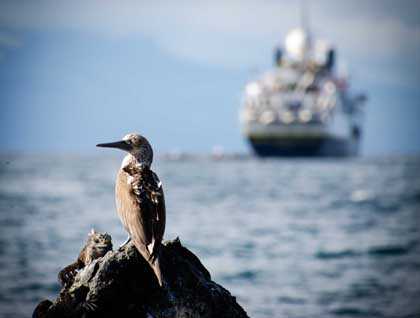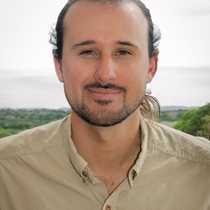This morning we set off for a wet landing at Urbina Bay on the western shores of Alcedo Volcano, on Isabela Island. This morning’s walk takes us over terrain which has been uplifted from the bottom of the shores of Isabela Island as recently as 1954. In just over half a century, the remains of many subaquatic organisms still show, as they are slowly consumed by a forest of arid zone vegetation. This region is just showing signs of new growth, as the first rains of the wet season have started to transform this area lying on the “rain shadow” of the massive Alcedo Volcano, which lies to the East of us. Blue-footed boobies, brown pelicans and Galapagos penguins fiercely attack a small shoal of fish on the shores of the small black sand beach as we disembark. The weather turns out to be excellent during our morning outing, as it remains partially cloudy, keeping the temperature to remain relatively low and allowing us witness lots of activity by some of the land species, like Galapagos land iguanas, mockingbirds and Darwin finches further inland.
As we enjoy a traditional Ecuadorian lunch, as Captain John Zurita sails the National Geographic Endeavour further north up the western coast of Isabela, back into the Bolivar Channel towards the Tagus Cove, which we will visit during the afternoon.
Tagus Cove on Isabela Island is located just southeast of Punta Espinoza on Fernandina, which we had a chance to visit yesterday. A group of volcanic ash cones lie on the southwestern shores of Darwin Volcano. Several of the cones contain saltwater lakes, and the westernmost cone has been eroded so badly by the elements that it offers the uncommon opportunity for ships to anchor in its center. From this anchorage, we have a chance to explore the surrounding shoreline to observe hunting flightless cormorants and Galapagos penguins, while both snorkeling and kayaking.
At the very end of the afternoon some naturalists and guests follow in Darwin’s footsteps, hiking around a saltwater lake through a forest of deciduous incense trees, which are being transformed by the first rains of the season.
As we return to our ship with the last light of the day, some of us are already wondering what Carlos Romero, our Expedition Leader, has in store for the next amazing day!







